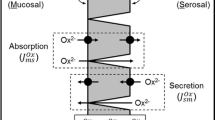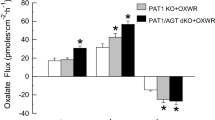Abstract
Urinary oxalate excretion is reduced in rats during a chronic metabolic acidosis, but how this is achieved is not clear. In this report, we re-examine our prior work on the effects of a metabolic acidosis on urinary oxalate handling [Green et al., Am J Physiol Ren Physiol 289(3):F536–F543, 2005], offering a more detailed analysis and interpretation of the data, together with new, previously unpublished observations revealing a marked impact on intestinal oxalate transport. Sprague–Dawley rats were provided with 0.28 M ammonium chloride in their drinking water for either 4 or 14 days followed by 24 h urine collections, blood-gas and serum ion analysis, and measurements of 14C-oxalate fluxes across isolated segments of the distal colon. Urinary oxalate excretion was significantly reduced by 75 % after just 4 days compared to control rats, and this was similarly sustained at 14 days. Oxalate:creatinine clearance ratios indicated enhanced net re-absorption of oxalate by the kidney during a metabolic acidosis, but this was not associated with any substantive changes to serum oxalate levels. In the distal colon, oxalate transport was dramatically altered from net absorption in controls (6.20 ± 0.63 pmol cm−2 h−1), to net secretion in rats with a metabolic acidosis (−5.19 ± 1.18 and −2.07 ± 1.05 pmol cm−2 h−1 at 4 and 14 days, respectively). Although we cannot rule out modifications to bi-directional oxalate movements along the proximal tubule, these findings support a gut-kidney axis in the management of oxalate homeostasis, where this shift in renal handling during a metabolic acidosis is associated with compensatory adaptations by the intestine.



Similar content being viewed by others
References
Green ML, Hatch M, Freel RW (2005) Ethylene glycol induces hyperoxaluria without metabolic acidosis in rats. Am J Physiol Ren Physiol 289(3):F536–F543. doi:10.1152/ajprenal.00025.2005
Coe FL, Evan A, Worcester E (2005) Kidney stone disease. J Clin Investig 115(10):2598–2608. doi:10.1172/jci26662
Sakhaee K, Maalouf NM, Sinnott B (2012) Kidney Stones 2012: pathogenesis, diagnosis, and management. J Clin Endocrinol Metab 97(6):1847–1860. doi:10.1210/jc.2011-3492
Asplin JR (2002) Hyperoxaluric calcium nephrolithiasis. Endocrinol Metab Clin North Am 31(4):927–949. doi:10.1016/s0889-8529(02)00030-0
Bushinsky DA, Grynpas MD, Asplin JR (2001) Effect of acidosis on urine supersaturation and stone formation in genetic hypercalciuric stone-forming rats. Kidney Int 59(4):1415–1423. doi:10.1046/j.1523-1755.2001.0590041415.x
Freel RW, Hatch M, Green M, Soleimani M (2006) Ileal oxalate absorption and urinary oxalate excretion are enhanced in Slc26a6 null mice. Am J Physiol Gastrointest Liver Physiol 290(4):G719–G728. doi:10.1152/ajpgi.00481.2005
Freel RW, Whittamore JM, Hatch M (2013) Transcellular oxalate and Cl− absorption in mouse intestine is mediated by the DRA anion exchanger Slc26a3, and DRA deletion decreases urinary oxalate. Am J Physiol Gastrointest Liver Physiol 305(7):G520–G527. doi:10.1152/ajpgi.00167.2013
Hatch M, Cornelius J, Allison M, Sidhu H, Peck A, Freel RW (2006) Oxalobacter sp reduces urinary oxalate excretion by promoting enteric oxalate secretion. Kidney Int 69(4):691–698. doi:10.1038/sj.ki.5000162
Hatch M, Gjymishka A, Salido EC, Allison MJ, Freel RW (2011) Enteric oxalate elimination is induced and oxalate is normalized in a mouse model of Primary Hyperoxaluria following intestinal colonization with Oxalobacter. Am J Physiol Gastrointest Liver Physiol 300(3):G461–G469. doi:10.1152/ajpgi.00434.2010
Hatch M, Freel RW (2003) Angiotensin II involvement in adaptive enteric oxalate excretion in rats with chronic renal failure induced by hyperoxaluria. Urol Res 31(6):426–432. doi:10.1007/s00240-003-0367-5
Hatch M, Freel RW (2003) Renal and intestinal handling of oxalate following oxalate loading in rats. Am J Nephrol 23(1):18–26. doi:10.1159/000066300
Costello JF, Smith M, Stolarski C, Sadovnic MJ (1992) Extrarenal clearance of oxalate increases with progression of renal-failure in the rat. J Am Soc Nephrol 3(5):1098–1104
Hatch M, Freel RW, Vaziri ND (1994) Intestinal excretion of oxalate in chronic renal failure. J Am Soc Nephrol 5(6):1339–1343
Charney AN, Dagher PC (1996) Acid-base effects on colonic electrolyte transport revisited. Gastroenterology 111(5):1358–1368. doi:10.1053/gast.1996.v111.agast961111358
Charney AN, Egnor RW, Henner D, Rashid H, Cassai N, Sidhu GS (2004) Acid-base effects on intestinal Cl− absorption and vesicular trafficking. Am J Physiol Cell Physiol 286(5):C1062–C1070. doi:10.1152/ajpcell.00454.2003
Hatch M, Freel RW (2008) The roles and mechanisms of intestinal oxalate transport in oxalate homeostasis. Semin Nephrol 28(2):143–151. doi:10.1016/j.semnephrol.2008.01.007
Hatch M (1990) Spectrophotometric determination of oxalate in whole-blood. Clin Chim Acta 193(3):199–202. doi:10.1016/0009-8981(90)90252-n
Nowik M, Kampik NB, Mihailova M, Eladari D, Wagner CA (2010) Induction of metabolic acidosis with ammonium chloride (NH4Cl) in mice and rats—species differences and technical considerations. Cell Physiol Biochem 26(6):1059–1072. doi:10.1159/000323984
Bushinsky DA, Favus MJ, Schneider AB, Sen PK, Sherwood LM, Coe FL (1982) Effects of metabolic-acidosis on PTH and 1,25(OH)2D3 response to low calcium diet. Am J Physiol Ren Physiol 243(6):F570–F575
Sajo IM, Goldstein MB, Sonnenberg H, Stinebaugh BJ, Wilson DR, Halperin ML (1981) Sites of ammonia addition to tubular fluid in rats with chronic metabolic-acidosis. Kidney Int 20(3):353–358. doi:10.1038/ki.1981.146
Rizzo M, Capasso G, Bleich M, Pica A, Grimaldi D, Bindels RJM, Greger R (2000) Effect of chronic metabolic acidosis on calbindin expression along the rat distal tubule. J Am Soc Nephrol 11(2):203–210
Bastani B, Purcell H, Hemken P, Trigg D, Gluck S (1991) Expression and distribution of renal vacuolar proton-translocating adenosine-triphosphatase in response to chronic acid and alkali loads in the rat. J Clin Investig 88(1):126–136. doi:10.1172/jci115268
Ambuhl PM, Amemiya M, Danczkay M, Lotscher M, Kaissling B, Moe OW, Preisig PA, Alpern RJ (1996) Chronic metabolic acidosis increases NHE3 protein abundance in rat kidney. Am J Physiol Ren Fluid Electrol Physiol 271(4):F917–F925
Kim EY, Choi JS, Lee KE, Kim CS, Bae EH, Ma SK, Kim SH, Lee JU, Kim SW (2012) Altered regulation of renal acid base transporters in response to ammonium chloride loading in rats. Korean J Physiol Pharmacol 16(2):91–95. doi:10.4196/kjpp.2012.16.2.91
Aruga S, Wehrli S, Kaissling B, Moe OW, Preisig PA, Pajor AM, Alpern RJ (2000) Chronic metabolic acidosis increases NaDC-1 mRNA and protein abundance in rat kidney. Kidney Int 58(1):206–215. doi:10.1046/j.1523-1755.2000.00155.x
Parry DM, Brosnan JT (1978) Glutamine metabolism in kidney during induction of, and recovery from, metabolic-acidosis in rat. Biochem J 174(2):387–396
Curthoys NP, Moe OW (2014) Proximal tubule function and response to acidosis. Clin J Am Soc Nephrol 9(9):1627–1638. doi:10.2215/cjn.10391012
Feldman GM (1989) Effect of chronic metabolic-acidosis on net electrolyte transport in rat colon. Am J Physiol Gastrointest Liver Physiol 256(6):G1036–G1040
Tosco M, Porta C, Sironi C, Laforenza U, Orsenigo MN (2011) Acute and chronic acidosis influence on antioxidant equipment and transport proteins of rat jejunal enterocyte. Cell Biol Int 35(4):345–353. doi:10.1042/cbi20100428
May RC, Kelly RA, Mitch WE (1986) Metabolic-acidosis stimulates protein-degradation in rat muscle by a glucocorticoid-dependent mechanism. J Clin Investig 77(2):614–621. doi:10.1172/jci112344
Caso G, Garlick BA, Casella GA, Sasvary D, Garlick PJ (2004) Acute metabolic acidosis inhibits muscle protein synthesis in rats. Am J Physiol Endocrinol Metab 287(1):E90–E96. doi:10.1152/ajpendo.00387.2003
Perrone RD, Madias NE, Levey AS (1992) Serum creatinine as an index of renal-function—new insights into old concepts. Clin Chem 38(10):1933–1953
Dawson PA, Russell CS, Lee S, McLeay SC, van Dongen JM, Cowley DM, Clarke LA, Markovich D (2010) Urolithiasis and hepatotoxicity are linked to the anion transporter Sat1 in mice. J Clin Investig 120(3):706–712. doi:10.1172/jci31474
Aronson PS (2006) Essential roles of CFEX-mediated Cl–oxalate exchange in proximal tubule NaCl transport and prevention of urolithiasis. Kidney Int 70(7):1207–1213. doi:10.1038/sj.ki.5001741
Wang T, Egbert AL, Aronson PS, Giebisch G (1998) Effect of metabolic acidosis on NaCl transport in the proximal tubule. Am J Physiol Ren Physiol 274(6):F1015–F1019
Markovich D, Aronson PS (2007) Specificity and regulation of renal sulfate transporters. Annu Rev Physiol 69:361–375. doi:10.1146/annurev.physiol.69.040705.141319
Jiang ZR, Asplin JR, Evan AP, Rajendran VM, Velazquez H, Nottoli TP, Binder HJ, Aronson PS (2006) Calcium oxalate urolithiasis in mice lacking anion transporter Slc26a6. Nat Genet 38(4):474–478. doi:10.1038/ng1762
Xie QH, Welch R, Mercado A, Romero MF, Mount DB (2002) Molecular characterization of the murine Slc26a6 anion exchanger: functional comparison with Slc26a1. Am J Physiol Ren Physiol 283(4):F826–F838. doi:10.1152/ajprenal.00079.2002
Puttaparthi K, Markovich D, Halaihel N, Wilson P, Zajicek HK, Wang HM, Biber J, Murer H, Rogers T, Levi M (1999) Metabolic acidosis regulates rat renal Na-Si cotransport activity. Am J Physiol Cell Physiol 276(6):C1398–C1404
Ohana E, Shcheynikov N, Moe OW, Muallem S (2013) SLC26A6 and NaDC-1 transporters interact to regulate oxalate and citrate homeostasis. J Am Soc Nephrol 24(10):1617–1626
Karniski LP, Lotscher M, Fucentese M, Hilfiker H, Biber J, Murer H (1998) Immunolocalization of sat-1 sulfate/oxalate/bicarbonate anion exchanger in the rat kidney. Am J Physiol Ren Physiol 275(1):F79–F87
Krick W, Schnedler N, Burckhardt G, Burckhardt BC (2009) Ability of sat-1 to transport sulfate, bicarbonate, or oxalate under physiological conditions. Am J Physiol Ren Physiol 297(1):F145–F154. doi:10.1152/ajprenal.90401.2008
Feldman GM, Charney AN (1980) Effect of acute metabolic alkalosis and acidosis on intestinal electrolyte transport in vivo. Am J Physiol 239(5):G427–G436
Charney AN, Haskell LP (1984) Relative effects of systemic pH, PCO2, and HCO3 concentration on colonic ion-transport. Am J Physiol Gastrointest Liver Physiol 246(2):G159–G165
Bachmann O, Seidler U (2011) News from the end of the gut-How the highly segmental pattern of colonic HCO3 − transport relates to absorptive function and mucosal integrity. Biol Pharm Bull 34(6):794–802
Rajendran VM, Binder HJ (2000) Characterization and molecular localization of anion transporters in colonic epithelial cells. In: Schulzke JD, Fromm M, Riecken EO, Binder HJ (eds) Epithelial transport and barrier function: pathomechanisms in gastrointestinal disorders, vol 915. Annals of the New York Academy of Sciences, pp 15–29
Rajendran VM, Binder HJ (1999) Distribution and regulation of apical Cl/anion exchanges in surface and crypt cells of rat distal colon. Am J Physiol Gastrointest Liver Physiol 276(1):G132–G137
Jennings ML, Adame MF (1996) Characterization of oxalate transport by the human erythrocyte band 3 protein. J Gen Physiol 107(1):145–159. doi:10.1085/jgp.107.1.145
Tresguerres M, Buck J, Levin LR (2010) Physiological carbon dioxide, bicarbonate, and pH sensing. Pflugers Archiv-Eur J Physiol 460(6):953–964. doi:10.1007/s00424-010-0865-6
Wagner JD, Kurtin P, Charney AN (1985) Effect of systemic acid-base-disorders on colonic intracellular pH and ion-transport. Am J Physiol Gastrointest Liver Physiol 249(1):G39–G47
Lucioni A, Womack C, Musch MW, Rocha FL, Bookstein C, Chang EB (2002) Metabolic acidosis in rats increases intestinal NHE2 and NHE3 expression and function. Am J Physiol Gastrointest Liver Physiol 283(1):G51–G56. doi:10.1152/ajpgi.00529.2001
Charoenphandhu N, Tudpor K, Pulsook N, Krishnamra N (2006) Chronic metabolic acidosis stimulated transcellular and solvent drag-induced calcium transport in the duodenum of female rats. Am J Physiol Gastrointest Liver Physiol 291(3):G446–G455. doi:10.1152/ajpgi.00108.2006
Pan M, Meng QH, Choudry HA, Karinch AM, Lin CM, Souba WW (2004) Stimulation of intestinal glutamine absorption in chronic metabolic acidosis. Surgery 136(2):127–134. doi:10.1016/j.surg.2004.04.005
Wongdee K, Teerapornpuntakit J, Riengrojpitak S, Krishnamra N, Charoenphandhu N (2009) Gene expression profile of duodenal epithelial cells in response to chronic metabolic acidosis. Mol Cell Biochem 321(1–2):173–188. doi:10.1007/s11010-008-9931-1
Acknowledgments
We are grateful to Anastasia Harris, Candi Morris, and Bonnie Murphy for their technical assistance during this study. This work was supported in part by a grant from the Oxalosis and Hyperoxaluria Foundation (OHF) to Dr. M. L. Green and National Institute of Diabetes and Digestive and Kidney Diseases Grant DK-56245 (M. Hatch) from the National Institutes of Health.
Author information
Authors and Affiliations
Corresponding author
Ethics declarations
The authors declare they have no conflict of interest.
Rights and permissions
About this article
Cite this article
Whittamore, J.M., Hatch, M. Chronic metabolic acidosis reduces urinary oxalate excretion and promotes intestinal oxalate secretion in the rat. Urolithiasis 43, 489–499 (2015). https://doi.org/10.1007/s00240-015-0801-5
Received:
Accepted:
Published:
Issue Date:
DOI: https://doi.org/10.1007/s00240-015-0801-5




